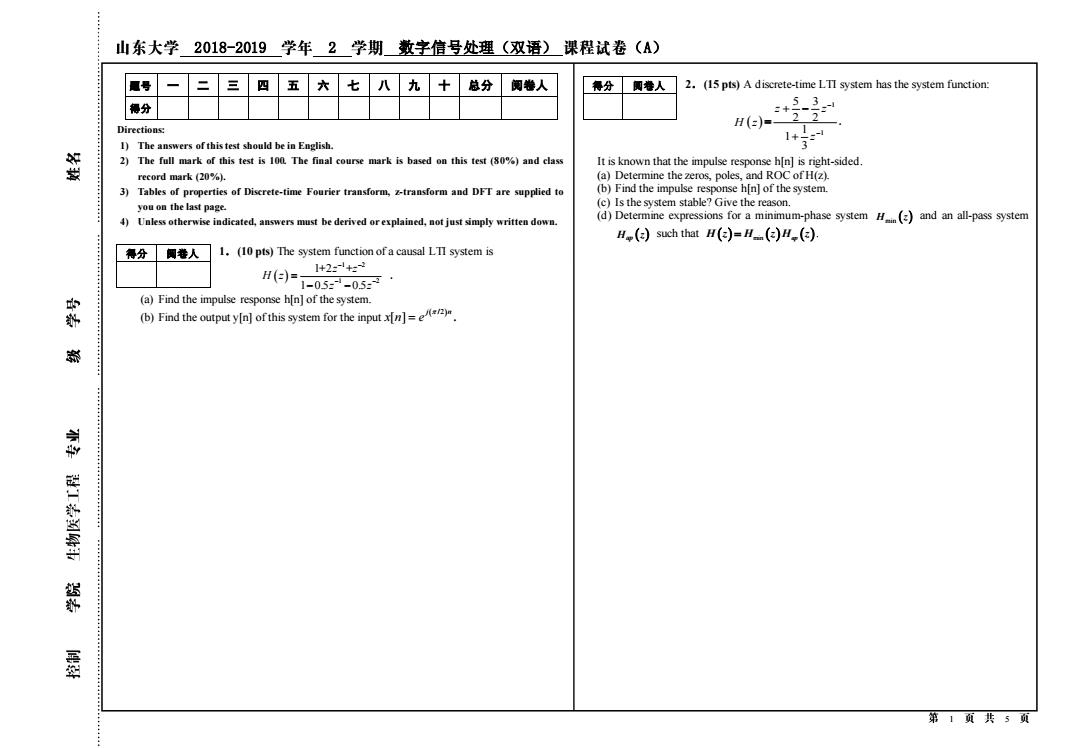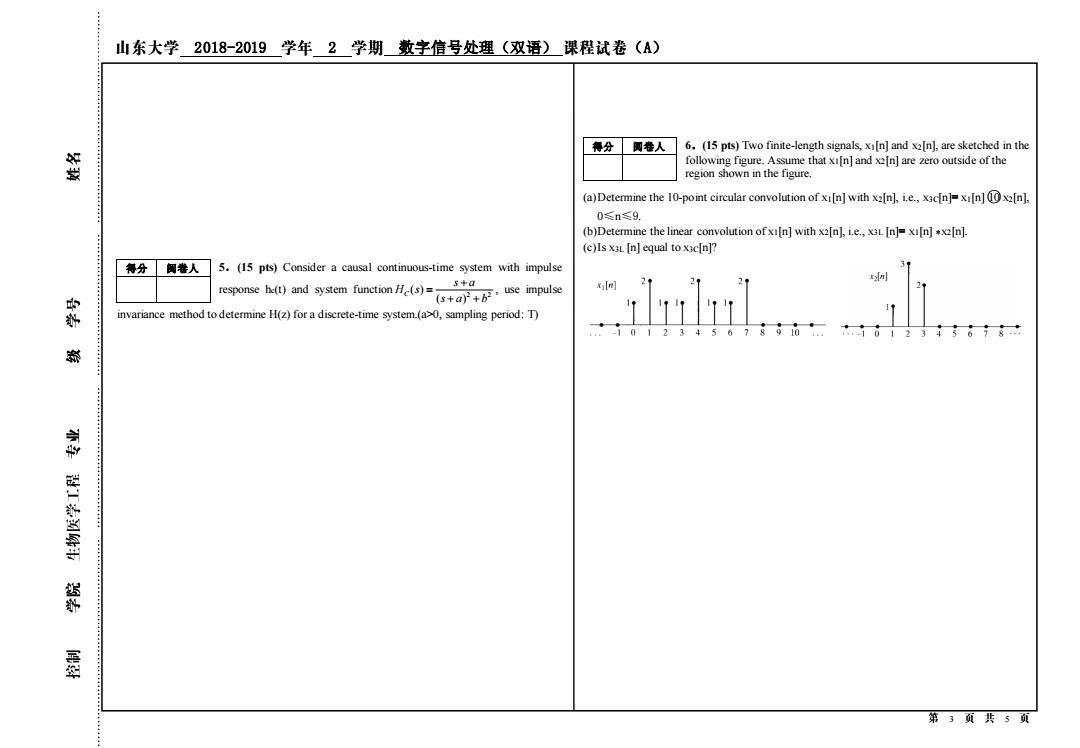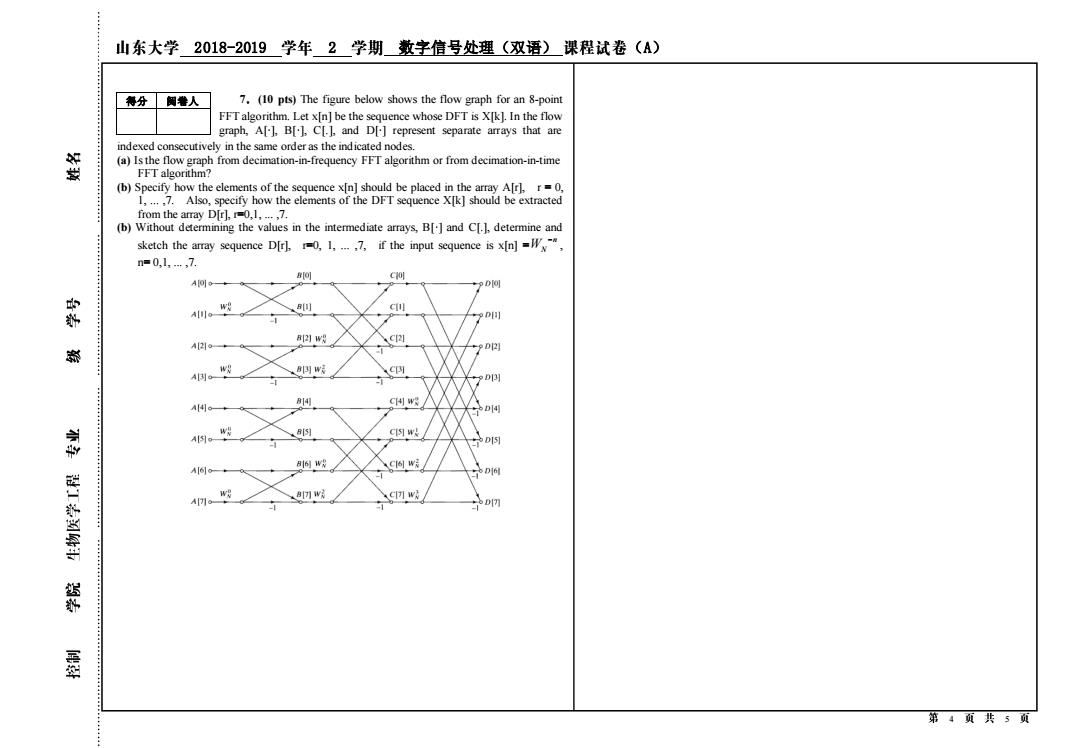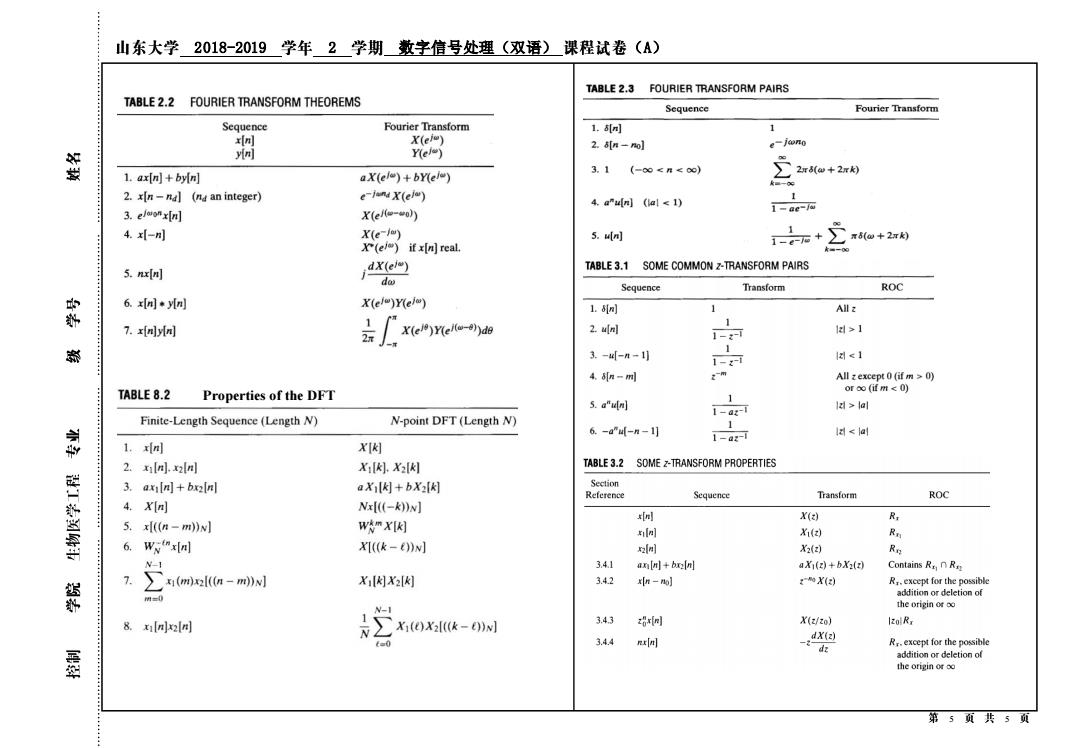
山东大学 2018-2019学年2学期数字信号处理(双语)课程试卷(A) 号 四 五大 七八九 总分 阅卷人 得分港人 2.(15 pts)A discrete-time LTI system has the system function 得分 53 +22 H()= Directions: 1)The answers of this test should be in English. 2)The full mark of this test is 100.The final course mark is based on this test (80%)and class It is known that the impulse response h[n]is right-sided. record mark (20%). (a)Determine the zeros,poles,and ROC ofH(z) 3)Tables of properties of Discrete-time Fourier transform,z-transform and DFT are supplied to (b)Find the impulse response hfn]of the system. you on the last page (c)Is the system stable?Give the reason. Unless otherwise indicated,answers must be derived or explained,not just simply written down. (d)Determine expressions for a minimum-phase system H()and an all-pass system H()such that H()=H()H(). 得分 阿卷人 1. (10 pts)The system function of a causal LTI system is H(e) 1+2:+22 1-052-05e- 都 (a)Find the impulse response hin]of the system. (b)Find the output y[n]ofthis system for the input 琴 第1共5页
2018-2019 2 数字信号处理(双语) (A) 1 5 题号 一 二 三 四 五 六 七 八 九 十 总分 阅卷人 得分 Directions: 1) The answers of this test should be in English. 2) The full mark of this test is 100. The final course mark is based on this test (80%) and class record mark (20%). 3) Tables of properties of Discrete-time Fourier transform, z-transform and DFT are supplied to you on the last page. 4) Unless otherwise indicated, answers must be derived or explained, not just simply written down. 1.(10 pts) The system function of a causal LTI system is ( ) 1 2 1 2 1+2 + 1 0.5 0.5 z z H z z z − − − − = − − . (a) Find the impulse response h[n] of the system. (b) Find the output y[n] of this system for the input ( /2) [ ] = j n x n e . 2.(15 pts) A discrete-time LTI system has the system function: ( ) 1 1 5 3 2 2 = 1 1 3 − − + − + z z H z z . It is known that the impulse response h[n] is right-sided. (a) Determine the zeros, poles, and ROC of H(z). (b) Find the impulse response h[n] of the system. (c) Is the system stable? Give the reason. (d) Determine expressions for a minimum-phase system H z min ( ) and an all-pass system ( ) H z ap such that ( ) min ( ) ( ) H z H z H z = ap . 得分 阅卷人 得分 阅卷人

山东大学 2018-2019学年2学期数字信号处理(双语)课程试卷(A) 得分港人 3.(15pts)The impulse response hin]for a Linear-Phase FIR system is 得分 侧港人 4.(20 pts)For an ideal discrete-time differentiator with linear phase,the shown in the following figure, frequency response is Hn(e)=(jo)emn,-π<o<π An FIR discrete-time differentiatorn is determined byh[w],wn]is a symmetric window of length(M+1). (a)Determine the system function. (a)Find the corresponding impulse responseof H(). (b)Determine the difference equation relating input x[n]and output y[n] (b)Prove the symmetry or anti-symmetry ofh([Mor (c)Draw the signal flow graph of direct form structure for the FIR linear-phase system with the smallest number of coefficient multipliers. h[M-n=-hr[可y (d)Determine the group delay of the system. (c)Prove the symmetry or anti-symmetry ofn](h[n]=h[M-n]or h[M-n]=-h[n]). (d)If M9,which type of FIR generalized linear-phase system theis? (e)If M=10,which type of FIR generalized linear-phase system theis? (f)Choose an appropriate M (between M=10 and M=9)for the FIR discrete-time 家 differentiator,and give the reason. 琴 第2项共5页
2018-2019 2 数字信号处理(双语) (A) 2 5 3.(15pts) The impulse response h[n] for a Linear-Phase FIR system is shown in the following figure, (a) Determine the system function. (b) Determine the difference equation relating input x[n] and output y[n]. (c) Draw the signal flow graph of direct form structure for the FIR linear-phase system with the smallest number of coefficient multipliers. (d) Determine the group delay of the system. 4.(20 pts) For an ideal discrete-time differentiator with linear phase, the frequency response is ( ) / 2 ( ) , . − = − j j M H e j e diff An FIR discrete-time differentiator h n is determined by h n h n w n = diff , w[n] is a symmetric window of length (M +1). (a) Find the corresponding impulse response h n diff of ( ) j H e diff . (b)Prove the symmetry or anti-symmetry of h n diff ( h M n h n diff diff − = or h M n h n diff diff − − = ). (c) Prove the symmetry or anti-symmetry of h n ( h[n]= h[M – n] or h[M – n] = -h[n]). (d)If M=9, which type of FIR generalized linear-phase system the h n is? (e) If M=10, which type of FIR generalized linear-phase system the h n is? (f) Choose an appropriate M (between M=10 and M=9) for the FIR discrete-time differentiator, and give the reason. 得分 阅卷人 得分 阅卷人

山东大学2018-2019学年2学期数字信号处理(双语)课程试卷() 得分 侧人 6.(15 pts)Two finite-length signals,x[n]and x2[n],are sketched in the following figure.Assume that x[n]and n]are zero outside of the region shown in the figure. (a)Determine the 10-point circular convolution of xi[n]with x2[n],i.e.,xacln]=xin]10x2[n], 0≤n≤9 (b)Determine the linear convolution of xi[n]with x2[n],i.e.,x3L[n]xn]*x[n]. (c)Is x3L [n]equal to x3c[n]? 得分侧卷人 5.(15 pts)Consider a causal continuous-time system with impulse 31 eponse ht)and ystem functione impulse x[m] 20 都 invariance method to determine H(z)for a discrete-time system.(a>0,sampling period:T) 123456 琴 第3项共5页
2018-2019 2 数字信号处理(双语) (A) 3 5 5.(15 pts) Consider a causal continuous-time system with impulse response hc(t) and system function 2 2 ( ) ( ) C s a H s s a b + = + + , use impulse invariance method to determine H(z) for a discrete-time system.(a>0, sampling period: T) 6.(15 pts) Two finite-length signals, x1[n] and x2[n], are sketched in the following figure. Assume that x1[n] and x2[n] are zero outside of the region shown in the figure. (a)Determine the 10-point circular convolution of x1[n] with x2[n], i.e., x3C[n]= x1[n]○10 x2[n], 0≤n≤9. (b)Determine the linear convolution of x1[n] with x2[n], i.e., x3L [n]= x1[n] *x2[n]. (c)Is x3L [n] equal to x3C[n]? 得分 阅卷人 得分 阅卷人

山东大学2018-2019学年2学期数字信号处理(双语)课程试卷(A) 得分阙人 7.(10 pts)The figure below shows the flow graph for an 8-point FFTalgorithm.Let x[n]be the sequence whose DFT is X[kl.In the flow graph,A[].B[],C[.],and D[]represent separate arrays that are indexed consecutively in the same order as the indicated nodes. (a)Is the flow graph from decimation-in-frequency FFT algorithm or from decimation-in-time FFT algorithm? (b)Specify how the elements of the sequence x[n]should be placed in the array A[r],r0, 1,....7.Also,specify how the elements of the DFT sequence X[k]should be extracted from the array D[r],r,1..7. (b)Without determining the values in the intermediate arrays,B[]and C[.],determine and sketch the array sequence D[r 1.....,if the input sequence is x[n]=W n=0,l…,7. B阿间 D阿 家 图W 、C2 恭 PD 。 因w C円 7D网 814 C刊w号 。整 5例 CIs]w D 6例wR A[61o 。 w 1 器 暴 第4项共5页
2018-2019 2 数字信号处理(双语) (A) 4 5 7.(10 pts) The figure below shows the flow graph for an 8-point FFT algorithm. Let x[n] be the sequence whose DFT is X[k]. In the flow graph, A[·], B[·], C[.], and D[·] represent separate arrays that are indexed consecutively in the same order as the indicated nodes. (a) Is the flow graph from decimation-in-frequency FFT algorithm or from decimation-in-time FFT algorithm? (b) Specify how the elements of the sequence x[n] should be placed in the array A[r], r = 0, 1, ... ,7. Also, specify how the elements of the DFT sequence X[k] should be extracted from the array D[r], r=0,1, ... ,7. (b) Without determining the values in the intermediate arrays, B[·] and C[.], determine and sketch the array sequence D[r], r=0, 1, ... ,7, if the input sequence is x[n] = n WN − , n= 0,1, ... ,7. 得分 阅卷人

山东大学2018-2019学年2学期数字信号处理(双语)课程试卷(A) TABLE 2.3 FOURIER TRANSFORM PAIRS TABLE 2.2 FOURIER TRANSFORM THEOREMS Sequence Fourier Transform Sequence Fourier Transform 1. 1 X(ei) 2.m-o】 e-jono 好 y Y(el) 1.ax(n]+byin] ax(el)+bY(el) 3.1(-o0n←0∞) 之2e+2r的 2.x(n-ndl (nd an integer) e-junX(ejo) 4.an(al1 游 3.-d-n- 1-x可 10) TABLE8.2 or oo (if m<0) Properties of the DFT 5.a"uln] 1-a可 la lal Finite-Length Sequence(Length N) N-point DFT (Length N) 6.-ad-n-1] la<lal 1.x(n] XI周 2.x[n].x2ln] X:[).X2[] TABLE 3.2 SOME z-TRANSFORM PROPERTIES 的 3.ax[n]+bx2in] aX因+bXl附 Section Reference Sequence Transform ROC 部 4.X Nx[((-k))N] xin] X(2) WmX[内 R: 5.xf(n-m》N 网l X R 6.Wyx[n] X(-)》N xale X2(z) Rn N 3.41 网+br aX(z)+bx2(z) Contains R:nR 器 ∑n(mxI(n-mjN X内X2R 3.42 x[n -no] 刷X() R.except for the possible m=0 addition or deletion of N-1 the origin oroo 8.x[n]x2In] x()x2((k-6)N] 3.43 网 X(z/zo) lzoRr 3.4.4 网 Rr.except for the possible 是 addition or deletion of the origin or oo 第5页共5页
2018-2019 2 数字信号处理(双语) (A) 5 5 Properties of the DFT